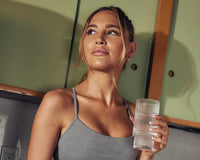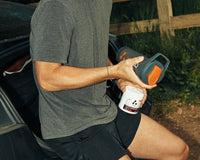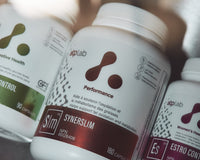Keeping "the lifter look" after 40+

I feel blessed that by in large, all my bodybuilding heroes of the Golden Era are still around and thanks to the internet, sharing their training wisdom with all. They achieved much with little compared to the "muscle labs" of today- the more progressive of these aging heroes embracing anything new of value and lending insightful commentary.
If you look at Arnold, Lou Ferrigno and others in current pics, they're still big with impressive backs and barrel chests, but like most of us as we age, the extremities start to lessen: Forearms, Calves, Hamstrings and Quads, even Upper Arms to some extent (luckily most of these guys had some to spare).
I recall chatting briefly on this back in the '80s with Vince "the iron guru" Gironda. In a nutshell, Vince maintained it was a combination of challenged circulation, innervation (feeling the contractions) and training volume for these parts that was to blame.
Future friend and mentor Charles Poliquin went further to fault challenged digestion (HCL levels and microbiome health- your probiotic status) along with lessening appetite or food digestibility. Indeed many times when Charles and I would dine he did not eat large meals ever but was judicious about supplementing digestive enzymes. He also had a palate for sushi, sashimi, steak tartar or rare cuts of meat and carpaccio. .all digesting significantly easier than that well-done steak or meatloaf. In other words, it was not what we ate in quantity but what we digested and absorbed in quality that dictated our body's nutritional status.
By in large most of the impressive champs of yesteryear that still pack visual impact also learned longevity did not come from bragging of your best 3rep max and moved to pursue an impressive 12 RM to even 25RM. Still, progressive resistance delivering hypertrophy but significantly easier on joints and connective tissue plus the lactate afforded lent to alternate growth factors of contribution.
Ken "Skip" Hill summed it up nicely in a recent article on continuing to build muscle in your 40's and beyond:
"Opening your chest day with heavy bench presses is asking for trouble. You might get away with it for a while, but it is a risk not worth taking. Most people can still do heavy compound movements, but opening with an isolation exercise like pec-deck flyes or cable flyes, as an example, would be a good option before moving to a heavier compound movement such as the bench press. Another option is doing your heavier compound exercises last for a muscle group.
Do you want to pull deads with minimal risk of injury? Do them as your last exercise for back instead of first. Remember, this is bodybuilding, so development is more important than sheer numbers (especially if you are older). Pre-exhausting all of the muscles of the back prior to pulling deads will allow less weight to be used after the muscles are warm, and this can minimize the risk of injury.
Other examples:
- Side laterals prior to overhead pressing
- Leg extensions and leg curls prior to squatting
- Cable press-downs for triceps prior to dips"
- As for exercise choice, doing what you're doing you got what you got and more often than not challenging the "standard" lends up "beyond standard" outcomes.
For example, accomplished powerlifter and bodybuilder, Paul carter summed up the worship of the deadlift for back development nicely:
"Standard deadlifts from the floor aren't a great exercise for back hypertrophy. They neither lengthen nor shorten any of the musculatures of the back. The muscles of the back just work in an isometric fashion to hold the spine in place and keep the loading at mid-foot.
From a tension standpoint, the first half of the movement is dominated by the glutes and hamstrings. As the bar comes over the knees and you have to pull it into place, it's the hip extension that does so, with (once again) the back working in an isometric fashion.
The scapula does go into a bit of retraction, but this can be accomplished by eliminating the bottom half of the pull, more or less, and doing rack or block deadlifts. Add bands to these to really hit the upper back.
If back hypertrophy is your goal, then skip the conventional deadlifts from the floor.
Deadlifts are also the most systemically taxing exercise. Think about this – a huge factor in making long term progress is to minimize systemic and neural taxation while maximizing muscular stress. So why would you choose a movement that maximizes neural and systemic stress, and minimizes muscular stress on the areas where you're trying to stimulate growth?.."
Returning to Vince's insights, we could go a step further. For the mathematicians out there, let's assign training volumes. As an example for chest/ arm flexor day:
- For Chest, we do "x" amount of volume
- For Biceps/ Brachialis we do "1.5x" in volume, and
- For Forearms, we do "2x" in volume
So it would look like Chest 10 sets, Arms 15 sets, and Forearms 20 sets
In all honesty, for those wanting to achieve the "Physique" look, this is probably sage advice as well, as it would clearly lend to the much-coveted "X-frame" as seen in our MARVEL heroes. I understand that it will not create impressive new lifts and for those chasing big numbers, little of this will apply. Indeed I recall a conversation with a very accomplished Dominican Strength Coach friend and he said,
"What's the point in getting big if you're not strong . ."
and I thought to myself,
"What's the point in getting strong if you don't look the part . ." - clearly my vanity gene kicking in. .the driving force behind 90% of commercial gym memberships.
So after all this, and you're a 40+ lifter wanting to keep "the look" or even create more "the look" of the lifter, let's put it all together:
Train your small muscles before your large ones (basically training "outside-in")
Do isolation or machine exercises before your compound bigger lifts
Spend more time (training volume) on the extremities than the midline of the body- it's where circulation and innervation are first to go
Keep the reps higher and pursue new 12RM's to 25RM's rather than 3RM's
Protect yourself from systemic and CNS fatigue with over-representation of the big lifts- even "enhanced" or genetically gifted, at 40+ something is waiting in the wings to give.
That said, invest in supplements of recuperation more than stimulation: Multi, Omega 3's, various Magnesium chelates, Melatonin, easily digested high-quality protein powders, Taurine, Glutamine, etc. . .
Support your digestion as well: fiber supplements (both soluble- prebiotic in nature, and insoluble- an intestinal broom), probiotics and of course digestive enzyme complexes
Pick proteins that are easy to digest so you are not dependant on eating the food volumes of a teen (think sushi, steak tartar, rare steaks, sashimi, ceviche, steak carpaccio,etc.). Much can be said about eating ancestral foods that clearly digest well for you, as well as rotating proteins to avoid food sensitivities.
That's a pretty decent thought provocation for the 40+ lot. Here's to looking as impressive on the other side of midlife as you were coming into it.
Who loves ya?
"Coach Mike"





